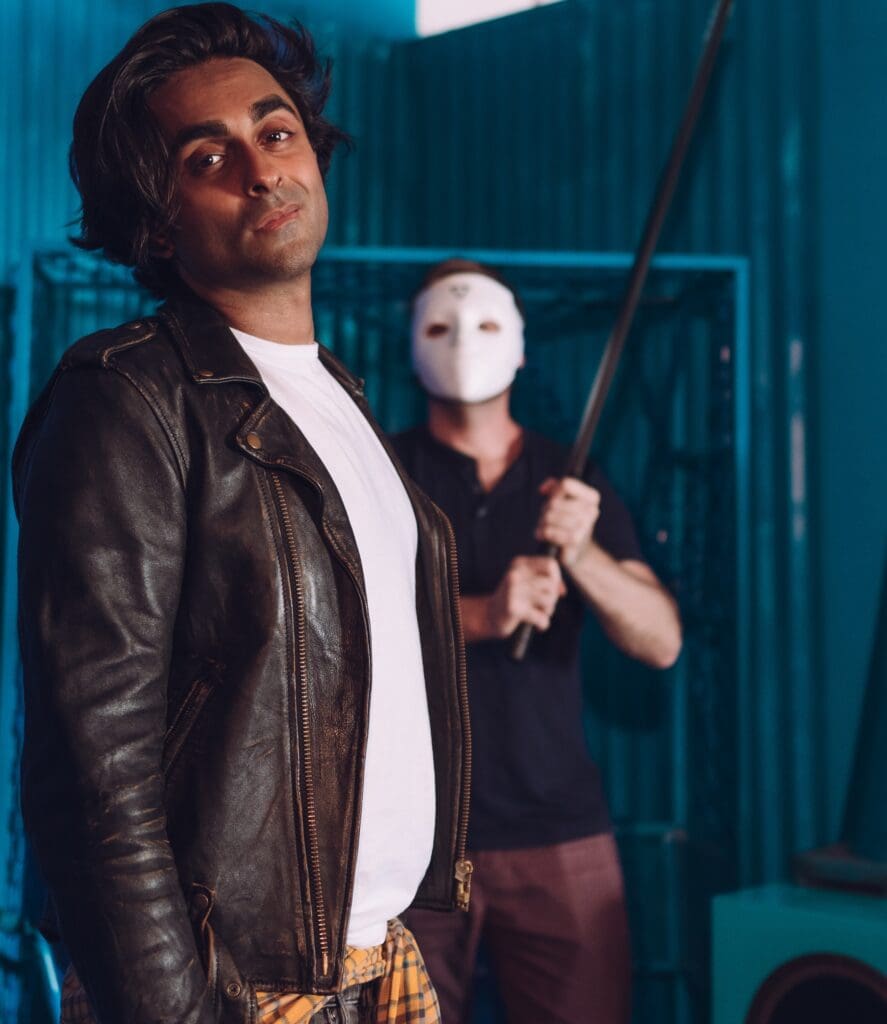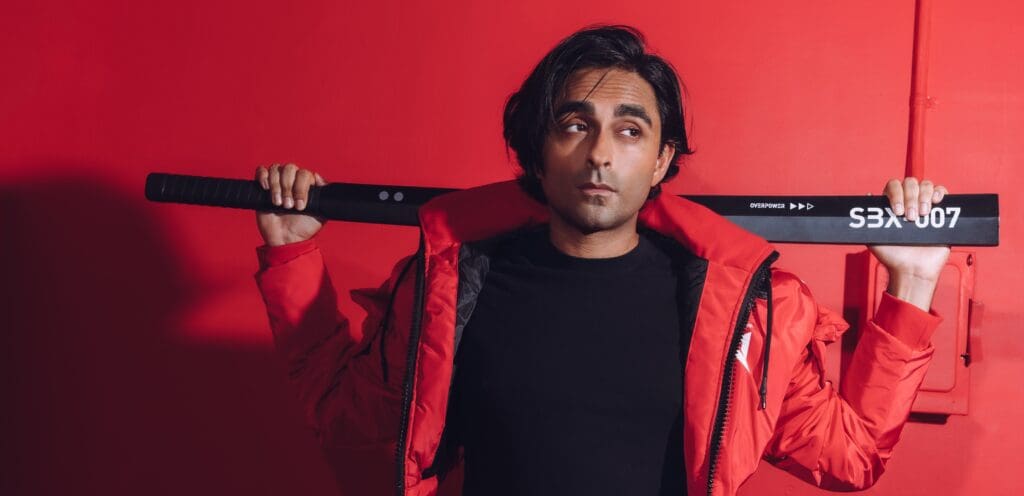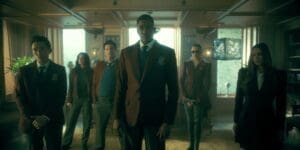Kieran Burt of Ready Steady Cut had the honor of interviewing the extremely talented creator Adi Shankar about the Netflix series Captain Laserhawk: A Blood Dragon Remix.
Captain Laserhawk: A Blood Dragon Remix is a six-episode anime on Netflix following Dolph Laserhawk (Nathaniel Curtis) in a dystopian world as he tries to take down the evil and technocratic government of Eden. It brings together several video game influences, especially from Ubisoft titles such as Far Cry 3: Blood Dragon, Assassin’s Creed, Rayman, and more, as Laserhawk meets new and wonderful characters on his way to bring down Eden.
Adi Shankar created the show, and it was produced by Ubisoft Film & Television and animated by the French studio Bobbypills. Shankar has also been an executive producer on the critically acclaimed Castlevania and Castlevania: Nocturne adaptations. We got to chat with Shankar about Captain Laserhawk: A Blood Dragon Remix, its potential for a second season, and his love of video games.
An Interview with Adi Shankar, Creator of Captain Laserhawk: A Blood Dragon Remix
Ready Steady Cut: How did Captain Laserhawk: A Blood Dragon Remix come about? Did you pitch it to Ubisoft or did they approach you?
Adi Shankar: I was already collaborating with Hugo Revon, Hélène Juguet, and the Ubisoft team on the development of another project. This was a “normal” project based on one of their games. Out of the blue, I decided to send them the pitch for Laserhawk, and to my delight, they were genuinely enthusiastic about it.
In response to their positive feedback, I delved deeper into the concept by writing a comprehensive bible for the project. It was at this stage that Gerard Guillemot, who heads Ubisoft’s film and TV division and is just an incredible leader, expressed his commitment to making this project a reality. Their exact words were, “We want to make this happen and will clear the path for you.”
The existence of this project owes to the fact that the Ubisoft Motion Picture and Television group fostered an open, friendly, and supportive environment. I felt seen and they created a space where I felt safe enough to bring them this unconventional pitch. As a group, they do a magnificent job of protecting artists and cultivating artists.
Ready Steady Cut: Captain Laserhawk: A Blood Dragon Remix isn’t a straight adaptation of Far Cry 3: Blood Dragon, but rather a remix with other Ubisoft games. Can you say a bit about why you decided to go in that direction and not a straight adaptation of Far Cry 3: Blood Dragon?
Shankar: This show is a living breathing universe populated with everything I love including several Ubisoft characters.
I decided to take the direction of creating a remix with other Ubisoft games rather than pursuing a straight adaptation of Far Cry 3: Blood Dragon because I had an entire universe living in my head that I was passionate about bringing to life. That vision never involved simply adapting an existing story. It was always about bringing this new universe to life.
That said, this project was inspired by the bold creative risk-taking spirit of Blood Dragon, and it felt right to pay homage to Blood Dragon’s spirit of innovation, which is why Blood Dragon is in the subtitle.
By remixing elements from various Ubisoft games, I had the opportunity to create something entirely original that I hope pays Ubisoft dividends for decades.

Adi Shanker | Image via Dexter Brown
Ready Steady Cut: You voiced the character of Red in Captain Laserhawk: A Blood Dragon Remix, what drew you to that character?
Shankar: When it came to voicing the character of Red in Captain Laserhawk: A Blood Dragon Remix, my initial inclination was actually to play Dolph. However, it became painfully clear that I wasn’t the right fit for that role. Nathaniel Curtis did such a fantastic job bringing the nuanced character of Dolph to life and as far as I’m concerned Nathaniel IS Dolph.
On the bright side, it turns out that playing a psychotic Power Ranger who flips out was a much better creative fit for me. Sometimes, you’ve got to know when to admit you’re not the right person for the job, and in this case, I think it worked out perfectly.
Ready Steady Cut: Episode 4 sees Captain Laserhawk and Sarah animated in a mix of live-action and anime. How did you pull that off and was it difficult?
Shankar: I believe that there are dimensions beyond our world and within our world that often go unnoticed. I wanted to play with the idea of dimensions and layers of reality. So in this universe when you go to virtual reality it becomes live action, but the real world is a cartoon. The intention was to invite the audience to question the boundaries of reality.
So the sequence in Episode 4 where Laserhawk and Sarah are animated in a mix of live-action and anime was made possible by our fearless director, Mehdi Laffad. It was indeed a challenging endeavor to pull off, but Mehdi’s creative vision and dedication made it happen.
Incorporating live-action into this project created a host of logistical complications, and it would have been easy to opt out of the live-action aspect. I’m immensely grateful to Netflix for their support in allowing this element to remain a part of the project. We were fortunate to have Mehdi as the director because, without his dedication, this fusion of live-action and anime wouldn’t have come to fruition.
Ready Steady Cut: What is your favorite reference to a Ubisoft game in Captain Laserhawk: A Blood Dragon Remix?
Shankar: My favorite references in Captain Laserhawk: A Blood Dragon Remix are actually to non-Ubisoft games. While Ubisoft has a rich catalog of iconic titles, there’s something special about paying homage to games from other developers that have had a profound impact on the gaming industry and culture. It’s a way of celebrating the broader gaming community and the diverse experiences it offers.
This series is a celebration of everything I loved as a child. We’re drawing from Saturday morning cartoons, anime, video games, and very serious dystopian sci-fi literature to deliver a morally complex thrill ride with twists around every corner. It’s a new genre of science fiction. It’s a newly invented subgenre of cyberpunk that I’m calling “Gameboypunk.”
Ready Steady Cut: There are some retro video game elements included in the show, like a top-down perspective of the action, a dialogue mini-game, or the hacking mini-game that Marcus did against Sarah. Did you include that to pay homage to something in particular or just that era of gaming?
Shankar: This series is essentially a love letter to gaming, not just to a particular era, but to the entirety of gaming culture. To explain further, the universe I’ve created for the series can be best described as a “videogame universe.” In this world, you’ll find power-ups, high-value items, and other elements that are reminiscent of what you’d encounter in a video game, but I’ve grounded them in the logic of a TV series. For instance, Alex’s bazooka in Episode 3 is a nod to the Nintendo Super Scope.
Additionally, we’ve integrated video game language into our storytelling to introduce a meta element and revolutionize how we tell the story. Cinema has had a century to develop its language, but video games are still in the process of evolving their own unique language. With this project, my goal was to harness the language of gaming to bring innovation to the language of cinema. It’s a fusion of two creative worlds, allowing us to explore new storytelling possibilities and engage the audience in a fresh and exciting way.
Again, I’ve coined all of this “Gameboypunk.”
Ready Steady Cut: What draws you to working on video game adaptations?
Shankar: Working on video game adaptations is genuinely exciting for me. I have a deep connection to video games that stems from my upbringing. I was born in 1985, so I’ve witnessed the rapid evolution of this medium throughout my life, and it’s been a significant part of my journey. You could say I’m plugged into gaming culture organically because of my age. I was part of the gaming community when it was still considered niche and when the graphics were still in pixels, which also adds a unique perspective to my work.
What really drives me in this field is the sense that I’m creating art for my younger self. I’ve had the opportunity to work on revisionist takes of iconic franchises like Power Rangers, Pokemon, and The Punisher. It’s a bit like revisiting my childhood passions and living out those childhood fantasies through my work. It’s incredibly rewarding to blend my love for video games with the chance to reimagine and breathe new life into these nostalgic favorites.
Ready Steady Cut: What draws you to adapt them in an anime format?
Shankar: It was just something I wanted to see and was confused as to why more of it didn’t exist.
Ready Steady Cut: Are you hopeful there will be a Captain Laserhawk: A Blood Dragon Remix season 2?
Shankar: The Laserhawk Universe is continuing to expand. We’ve got the Trackmania DLC set in Mega City 2 and the Rainbow Six: Siege DLC where you can play as Dolph Laserhawk and Jade. We also have an excellent canonical yaoi manga from TokyoPop written by Ben Kahn and supervised by me dropping on November 14.
But yes, I would like there to be more Laserhawk on Netflix.
RELATED: Captain Laserhawk: A Blood Dragon Remix Season 1 Ending Explained



